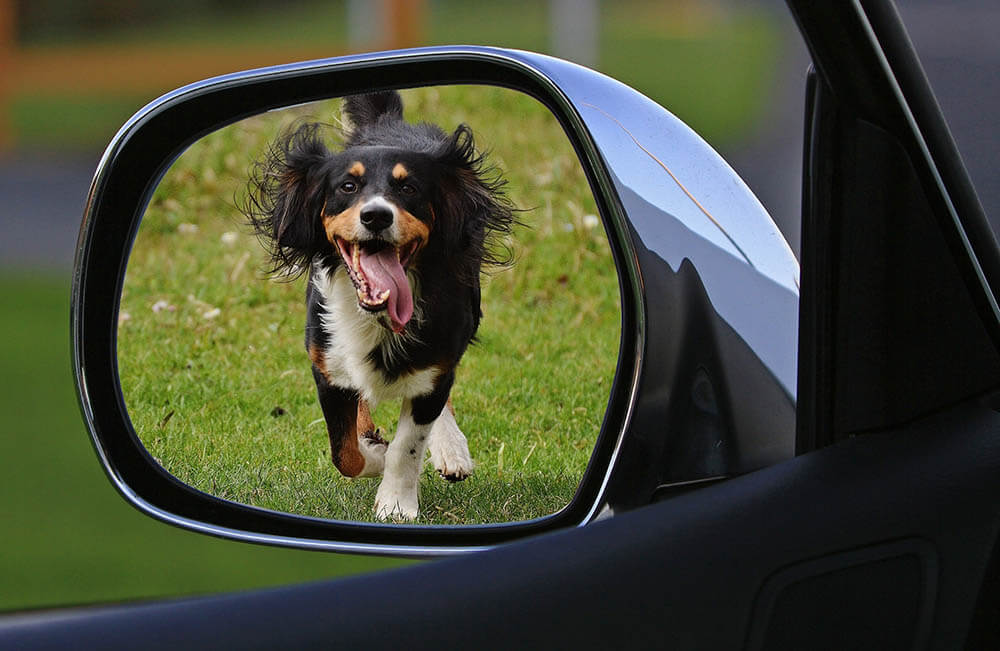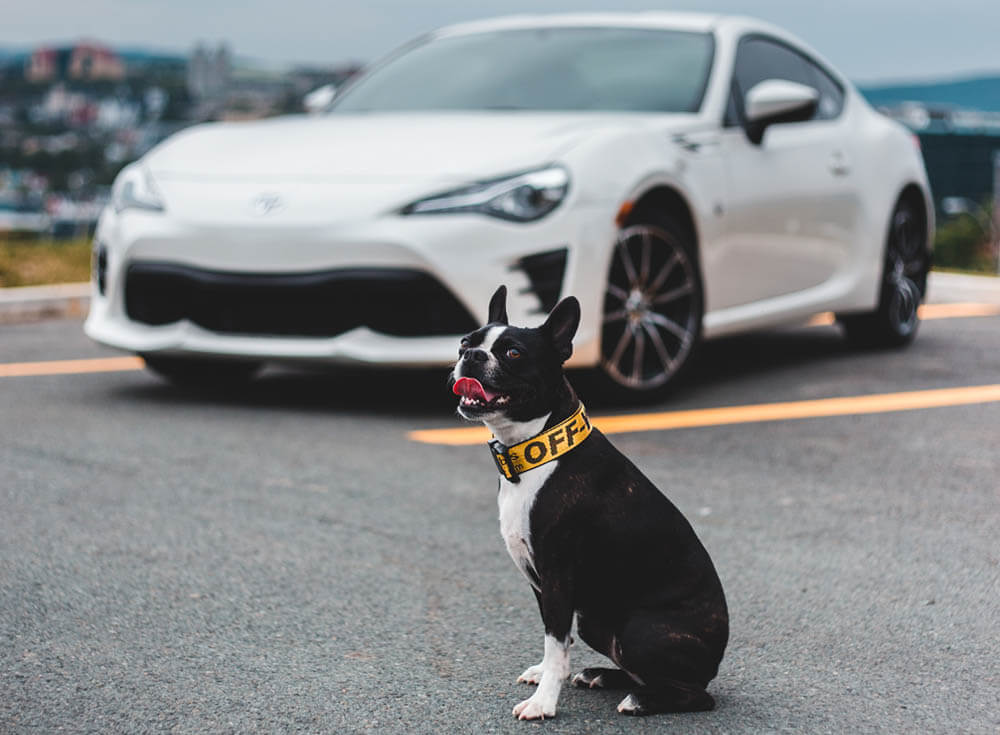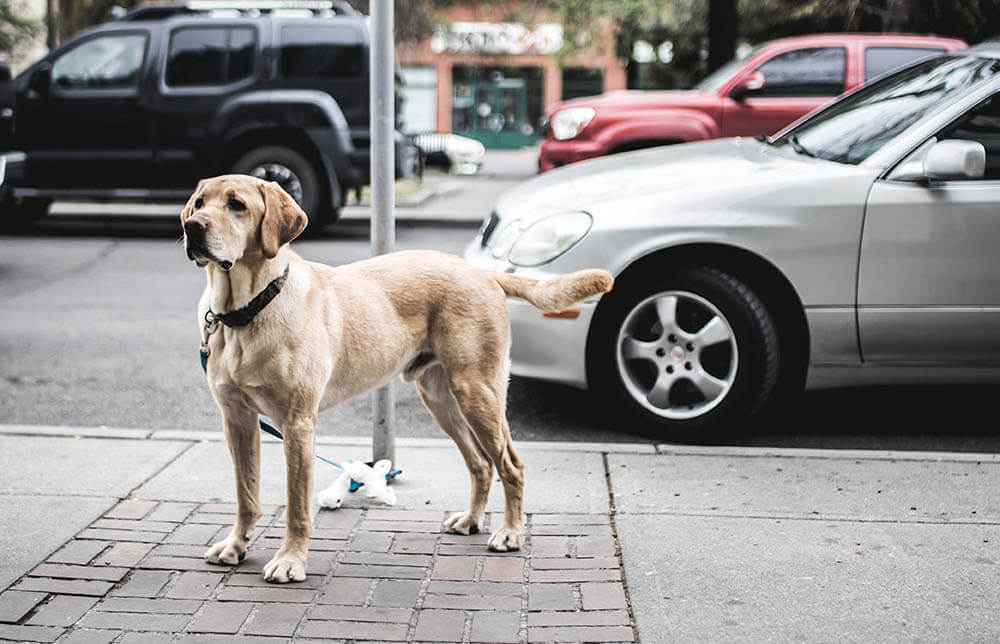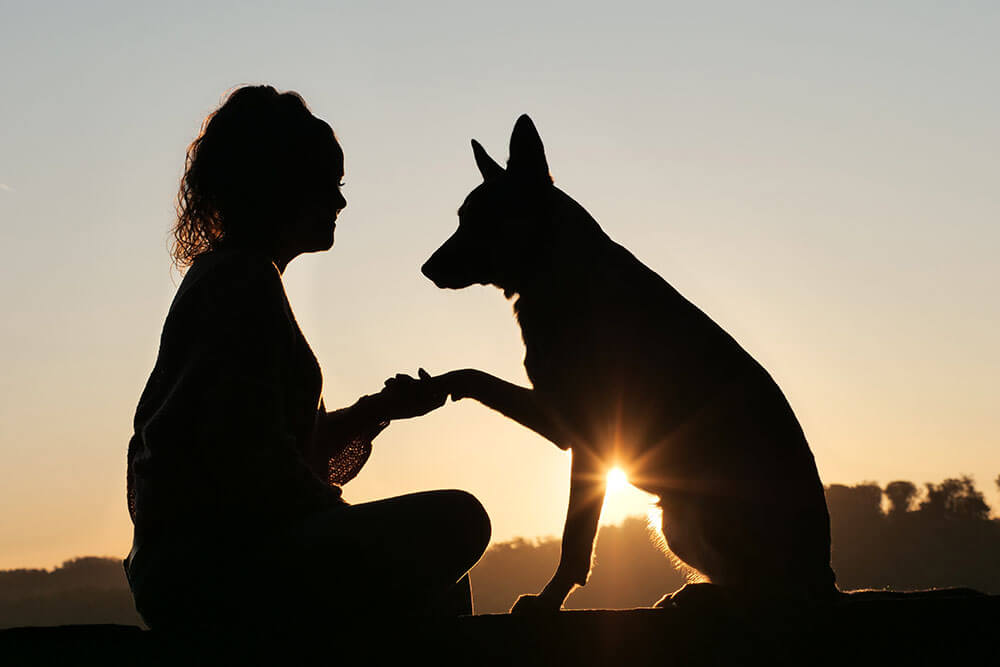Dogs do a lot of things that leave us scratching our heads. Some behaviors, however, are more worrying than others.
If your dog has a habit of chasing cars, then you know how terrifying it is when a beloved pet charges into the street after something far larger and heavier than them. What if that car comes to an abrupt halt? Or what if the driver of another car doesn’t see your dog? There are so many ways your pooch could get hurt.
To know how to stop any behavior, we should first determine its root cause. With that in mind, let’s explore the reasons why dogs chase cars and the ways to prevent our pets from getting into accidents.

Top 7 Reasons Why Dogs Chase Cars
Here are the 7 main reasons why dogs chase cars.
1. Dogs have a natural prey drive
We may have domesticated dogs, but our pets still retain the strong predatory instinct they inherited from their wild descendants. This means that when potential prey (such as a mouse, squirrel, or cat) races away from a dog, the dog may feel an irresistible urge to hunt it down for food.
Interestingly enough, some dogs will chase anything – even non-living objects far larger than them, such as cars. This doesn’t necessarily mean the dog intends to eat the car; it just means the car’s quick motion kicked the dog’s hunter’s instinct into high gear, provoking them to give pursuit. Dogs rush after large animals, such as humans, for the same reason.
Of course, some dogs may mistake the car’s smaller parts, such as the hubcaps, for small animals that can be eaten.
Breeds created to hunt game are more likely to chase cars.
2. Dogs love to play
Dogs love to have fun, and for many of our canine friends, running is one of the greatest joys in life. It’s even more pleasurable when they have a target to chase, such as a fur parent, four-legged family member, or car.
The thrill doggos experience when running after fleeing targets is linked to their prey drive. As previously discussed, however, dogs don’t always pursue creatures or things to eat them. Canines aren’t mindless; they know what they can and can’t eat, so they wouldn’t dine on anything made of metal or their beloved human. In many cases, the chase itself, and the joy it provides, is the end goal.
3. Dogs get bored
Like all intelligent, emotionally complex creatures, dogs experience boredom. And boredom is among the main reasons behind strange and/or destructive behaviors in canines.
Maybe you haven’t been walking your pooch or giving them any other type of exercise. Maybe they don’t have toys or fellow pets to play with. Whatever the case is, the lack of physical and mental stimulation can leave your pet bored.
When they see a car moving, your bored dog grabs the opportunity to have fun, so they chase it. Not only do they get to enjoy themselves but they also release all the pent-up energy so many hours of inactivity have resulted in.

4. Dogs protect their family and territory
Canines are extremely protective of their pack, which in the case of the domestic dog includes their adopted human family. And like their wild cousins, our pet pooches are also highly territorial.
If a dog sees, hears, or smells anything that they perceive as a potential threat to family and territory, they’ll bark in an attempt to drive it away. If it backs off, they may even chase it as if to say, “And don’t come back!”
A car’s size and the irritating noises it produces can make it seem dangerous to a dog. In other words, a dog chasing a car could simply be a dog protecting their family and home.
5. Dogs don’t want to be abandoned by loved ones
Does your dog chase the car you or another loved one is riding? Then your dog is probably afraid you’re abandoning them.
Dogs love their owners. Chasing your car may therefore be your pet’s attempt to stop the car so you don’t have to leave, or to join you wherever you’re going.
Such dogs may be suffering from anxiety. Separation anxiety, to be specific, causes a dog to live in constant fear that their loved ones are going to abandon them, and thus freak out at the slightest hint that you’re going away. This issue is common among rescue dogs that have suffered abuse and neglect under a bad owner.
If you think your dog has anxiety issues, know that a vet can help.
6. The behavior gets attention
Our dogs seek our attention for various reasons. Maybe your hungry pet wants to remind you it’s time to feed them. Maybe they kicked their favorite toy under the sofa and they need your help to retrieve it. Or maybe you’ve been so busy with work that you’ve been ignoring them for extended periods.
Dogs need our affection. If we don’t interact with them, they could feel bored, neglected, or unloved. Such feelings encourage them to engage in attention-seeking behaviors such as barking or staring at you until you can feel their eyes boring into your soul.
Other attention-seeking behaviors are weirder. If you reward your dog with attention whenever they chase cars, they’ll repeat the behavior to get you to interact with them. Some dogs even resort to destructive actions, such as chewing the couch or tearing your slippers to shreds.
7. The behavior was positively reinforced
Positive reinforcement is an extremely effective training technique that entails rewarding desired behaviors to encourage a dog to repeat said behaviors. For example, when a dog obeys a command to “sit,” you can give them a reward in the form of praise, a treat, or any other positive action. The next time they hear the command, they’ll obey in anticipation of the reward.
Unfortunately, many owners unintentionally reward undesirable behaviors, too. Did you smile or laugh the last time your dog chased a car? Such positive reactions could convince a dog that chasing cars is acceptable behavior. The dog will then keep chasing cars to make you happy or to gain your attention.

The Dangers of Car-Chasing and What You Can Do About It
Some may find it amusing to see a dog chase a car, but the behavior can also put any pet at serious risk of injury or worse. If the car suddenly stops, your dog could smack into it. Or another car could hit or run over your dog, causing severe, potentially life-threatening damage.
A dog that chases cars may also end up pursuing fast-moving living things, such as people on roller skates. In their excitement, the dog may even bite the person upon catching up with them.
For such reasons, you should curb your dog’s car-chasing behavior before it gets them into trouble. Here are a few tips on how to do that.
1. Keep your dog physically and mentally stimulated
Dogs should get lots of physical and mental exercise to prevent boredom and the troubling behaviors boredom causes.
Daily walks are a must. Walks give dogs the exercise they need not only to stay fit but also to release pent-up energy. In addition, walks expose dogs to exciting new scents, sounds, sights, and experiences, all of which nourish the mind.
Don’t limit your dog’s activities to walks. Play games such as tug and fetch with them. Let them run around in the yard. Take them to pet-friendly parks, beaches, and similar locations so they can meet other dogs and humans and experience new environments. Bring them with you when you go hiking so they can enjoy the marvels of nature. Also, don’t forget to give your dog toys. Puzzle toys and games are particularly great at preventing boredom as they engage your dog’s mind.
2. Train your dog
Training is of utmost importance if you want a confident, well-behaved dog.
Using proper training techniques, you can teach a dog that chasing cars is undesirable behavior. For example, you can “punish” a dog by giving them a stern “Stop!” or “No!” every time they chase a car, then having them go inside the house or their crate. Then, every time you see them watching but not going after a car, reward them by scratching them behind the ears, giving them a belly rub, feeding them a treat, or any other type of positive reinforcement. Over time, your dog will associate negative experiences with pursuing moving cars and positive experiences with the opposite, thus ending the behavior.
In addition, training strengthens the canine-human bond, which deepens your pet’s trust in you, helps reduce their anxiety levels, and elevates their feelings of safety and security. These can all help reduce or eliminate odd, potentially dangerous behaviors such as chasing cars.
Be mindful of your own actions so you don’t unintentionally reward undesirable conduct.
Never shout at or physically hurt your dog when punishing them as such actions can increase their anxiety, resulting in more behavioral problems. Stick with positive reinforcement. Hiring a professional dog trainer/animal behaviorist and enrolling your dog in training/obedience classes are also excellent ideas.
3. Give your dog lots of affection
An unhappy dog is more likely to act out than a happy, content one.
Give your dog lots of positive attention so they never feel neglected. Talk to them in sweet, soothing tones. Rub their belly and scratch them behind the ears. Always make time for your dog whenever they show signs of boredom.
You should also feed and walk your dog on time, as routines can boost their feelings of safety and security.
4. Install a fence around your property
A fence of moderate height will prevent your dog from chasing after cars while still allowing them to see the world outside your property. Combine this with training so your dog remains calm even when they see fast-moving things.
Alternatively, you can simply have a tall fence built around your property. This will prevent your dog from seeing cars in the first place.
When deciding how tall your fence should be, keep in mind that some dogs are escape artists. Huskies, for example, are known to climb or jump high fences.
5. Talk to a vet
Health problems can make a dog behave in strange ways. For example, stomach pain, poisoning, and anxiety are all issues that can make a dog restless and more likely to act out when bothered by something like a moving car.
Contact a vet if your dog is always restless and/or if that restlessness is accompanied by other health issue symptoms such as:
- Excessive panting
- Excessive licking of the lips or other body parts
- Excessive chewing of paws or other body parts
- Vomiting or retching/failure to vomit
- Diarrhea
- Shivering
- Rapid breathing
- Collapse
- Social withdrawal
- Pain (evidenced by whining or display of aggression when a specific body part is touched)
Vets can treat various ailments and thus end odd behaviors. If your dog has anxiety issues, a vet can even prescribe calming, anti-anxiety medications.
It’s also a good idea to consult an animal behaviorist. These professionals can figure out the root of your dog’s behavioral problems, then develop strategies to fix them.

Training Tips
There are many ways to train a dog to stop chasing cars. Here are some tips to help you get started.
1. You should start training a puppy as soon as they’re 8 weeks old. This can help prevent the car-chasing behavior long before your dog develops a desire to chase cars.
2. Teach your dog essential basics such as “Stay,” “Sit,” “Stop,” and “Come” as early as possible.
3. Once your dog understands said basics, ramp up the training difficulty by giving them a “target” to chase. For example, while telling your dog to stay, you can slowly walk away from them. Reward them for staying. If they disobey, “punish” them by giving them a stern “No!” and withholding their reward.
As the lessons progress, you should increase the speed of your retreat until you’re running. You should also introduce new challenges by changing the scenario. For example, instead of being on foot, you can back away from your dog while you’re using roller skates or while you’re inside a car, steadily picking up speed every training session. You can also have another family member, a friend, or another pet do the backing away instead of you.
4. Keep your dog leashed at all times during training sessions until you’re absolutely sure you can trust them not to give pursuit.
Check out our guide on how to train puppies! Remember, however, that while it’s best to train dogs when they’re still puppies, it’s never too late to train any dog.

Conclusion
Dogs chase cars for various reasons, from a natural urge to hunt down prey to a frantic attempt to keep their owners from abandoning them. Whatever the case is with your dog, it’s best to curb this behavior before it results in tragedy.
So love your dog, train them, and keep them physically and mentally stimulated. Consider having a fence built around your property. And if your dog is showing signs of health problems, make sure to ask a veterinarian for help!
